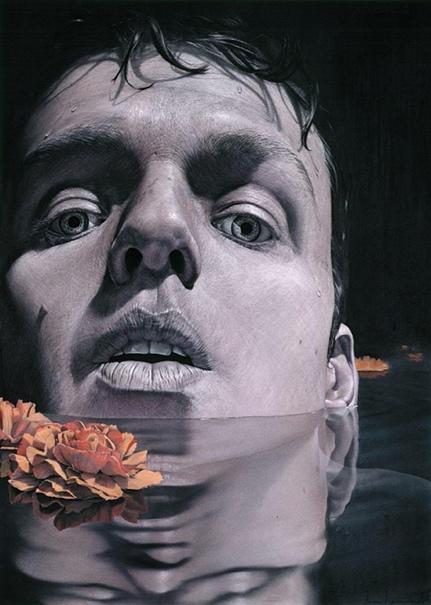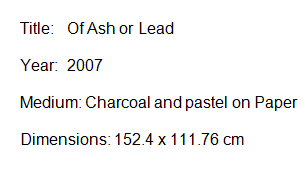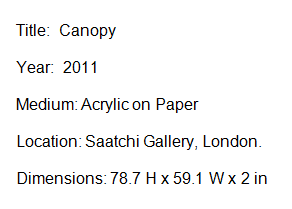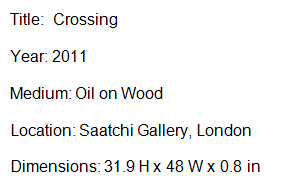Ian Ingram


Ian Ingram’s large-scale self-portraits catch the audience’s attention because of their psychoanalytic content because the artist tries to represent the connections between the spirit and body in his works. This work is unusual because in spite of using traditional graphite and charcoal for drawing, Ingram does not focus on the contrast of black and white colours, but he uses all the shades of the grey colour. The work states the idea that the “location of the soul was not necessarily in the body”, and the focus is not on the man trying to breathe above the water, but on the vivid flowers on the water surface (Ian Ingram 2014). Ingram’s work is interesting because it accentuates the contrast between life and death with references to the personal vision of transcendence.
Ellie Benuska


While painting, Ellie Benuska concentrates on demonstrating her relationship with the universe and her personal interpretation of the world. Thus, the artist tries to convey the idea about the contrast between the personal world and the universe. Benuska’s works are discussed as intimate expressions with the help of which the author allows looking in her world (Ellie Benuska 2014). This large-scale self-portrait is impressive because the artist demonstrates two sides of her nature. One of the depicted women is frowning, and the other one seems to be indifferent. It is possible to state the portrait represents not only the artist’s double nature but also her reaction to the specific world situations, and this openness attracts the viewer.
Oliver Duckworth


Oliver Duckworth is one of the artists who pay much attention to foreshortening the human body while focusing on the objects of the external world and details. It is possible to state that Duckworth’s works are most influenced by his surroundings, and many photographs are taken in the streets (Oliver Duckworth 2014). Looking at Duckworth’s photograph, the viewer sees a child as the main character, but all the attention is paid to extremely large objects such as a ball and a cup in the child’s hands. The work reminds that the objects of the external world can be very important in the people’s lives, and they even can be put to the forefront in the photograph and life.
Josh Bowe


Josh Bowe’s philosophy is based on presenting vigour objects which can be discussed as figurative and even abstract. Bowe’s painting is often discussed as intuitive because the presented characters and objects are not correlated with reality, but they are perceived as unreal ones (Josh Bowe 2014). Bowe’s paintings where the subject is associated with depicting naked persons impress because of the use of unique gloomy colours. For instance, “Canopy” is associated with screaming because the face of the depicted woman attracts the viewer’s attention and provokes the negative associations. The gloomy effects are the results of the artist’s work with textures, colours, and contrasts.
Annika Romeyn






Annika Romeyn is famous for her work with micro and macro objects. The artist represents real-life objects from an unusual perspective. Experimenting on the representation, Annika manipulates the viewer’s perception of the work. Thus, the series representing the autumn leaves is unique because leaves are presented from different angles. To accentuate luminosity of the decayed nature, the artist uses watercolour (Annika Romeyn Artist Profile 2014). Annika Romeyn’s works seem to be influenced by the objects of nature, but the aspects of representation allow thinking about the revised connections between the environment and human.
Flavio Apel


Flavio Apel’s photorealistic drawings are unique because they cause the viewer to think about the drawings as photographs. The focus on the details and strokes is extreme. It is even impossible to believe that such works as “Eye Drawing 1” from the eyes series are drawn with the help of the only pencil. Flavio Apel prefers to work with micro and macro representations in order to express his vision of the human world (Flavio Apel 2014). The work provokes a lot of positive emotions because of its specific precision. The artist seems to achieve his goal to impress the viewer.
Miguel Laino


Miguel Laino’s artworks are philosophical and symbolic. As a result, there are many variants to interpret the artist’s main idea reflected in the painting known as “Stepping across the edge of the in-between”. Researchers note that this Laino’s work reveals the idea of maturity (Miguel Laino 2014). However, it is also possible to discuss the painting as the representation of the person’s balancing at the edge between two different worlds or worldviews. This work makes the viewer think much about the role of the white figure represented in the painting and about the choice made by the man depicted in work.
Matthew Carter


On the one hand, Matthew Carter depicts real-life objects and persons while experimenting on the position of the human body in space. On the other hand, Carter discusses a lot of philosophical questions in his works. The discussed work draws the viewer’s attention to the role of the crossing in the people’s life (Matthew Carter 2014). It seems that if two men cross the road, they can change their life significantly, and these changes cannot be good because of the author’s use of many grey tones. Thus, space seems to be dangerous and full of challenges.
Frieda van Voorst


Frieda van Voorst’s style is unique because of the artist’s use of the text in her works. The artist’s philosophy depends on the idea that the world is full of signs, symbols, and literary messages which can be easily combined. This technique allows the creation of many abstract and figurative compositions made from texts and drawings (Frieda van Voorst 2014). The artist’s work is impressive because it demonstrates the harmony of integrating the watercolour drawings and textual messages.
Lucy C Gans


The works by Lucy C Gans demonstrate how it is possible to combine images and texts in order to convey certain ideas. “Murder-Suicide” is one of the artist’s self-portraits which are made in her specific technique (Lucy C Gans 2014). The position of the depicted character makes the viewer discuss the topic of the artwork as control and power. Thus, the artist seems to try to control her life. Much attention should be paid to the words because the text also plays a crucial role in creating the idea.
Reference List
Annika Romeyn. 2014. Annika Romeyn Web.
Annika Romeyn Artist Profile. 2014. BMMAG. Web.
Ellie Benuska. 2014. Ellie Benuska Portfolio. Web.
Flavio Apel. 2014. Saatchi Art. Web.
Frieda van Voorst. 2014. Saatchi Art. Web.
Ian Ingram. 2014. Ian Ingram Web.
Josh Bowe. 2014. Saatchi Art. Web.
Lucy C Gans. 2014. Saatchi Art. Web.
Matthew Carter. 2014. Saatchi Art. Web.
Miguel Laino. 2014. Saatchi Art. Web.
Oliver Duckworth. 2014. Saatchi Art. Web.